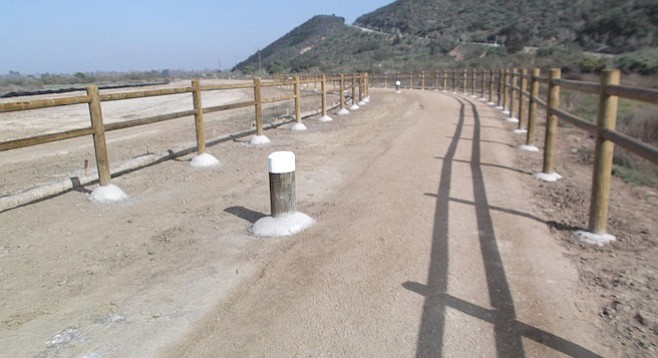 Facebook
Facebook
 X
X
 Instagram
Instagram
 TikTok
TikTok
 Youtube
Youtube

After a safety officer for the Border Patrol union raised concerns, San Diego County Parks & Recreation officials agreed to remove some recently installed bollards and fences from and alongside trails in Tijuana River Valley Regional Park.
"We are working with the Border Patrol to address their concerns," county spokesman Mike Workman said.
Last week, the Reader reported that dozens of bollards were being set in concrete down the middle of trails on the mesas and in the valley, in part to restrict Border Patrol movement in the area. Border Patrol agents catch more than a thousand people crossing illegally through the area between the San Ysidro Port of Entry and the Pacific Ocean every year — about a fifth of whom have been deported to Tijuana after serving U.S. prison sentences, according to Border Patrol statistics.
So far, the county has agreed to remove seven of the bollards, to remove some of the new fencing, and to immediately paint and add reflectors to new structures that are difficult to see in the dark. County parks and Border Patrol officials have also committed to weekly construction meetings. More changes may be made if they are needed, Workman said.
Problems arose during a phase of trail construction and improvement in the park. County parks is doing the improvements based on a 2006 plan. Funding for the multimillion dollar project became available recently from the county's settlement with the Department of Homeland Security over the fed's taking of more than 127 acres of the south end of the park. Coastal Conservancy grants also helped fund the project.
Proper trails to the high mesas south of Monument Road and just north of the U.S.-Mexico border will be established for the first time; the area is full of informal trails and Border Patrol roads, many of which are being closed and revegetated.
Border Patrol managers say that the project has had an impact on enforcement activities.
"There have been got-aways in this area since the county project's inception, in early February," an official statement said. "However, we cannot directly attribute this to the county infrastructure project."
Once illegal crossers are spotted in this area, agents have minutes to catch them before they disappear into San Ysidro, Imperial Beach, or into pick-up cars waiting for them less than a mile from the border.
After the Reader broke the story, Workman called a meeting of parks and Border Patrol officials to hammer out solutions. Among the problems, Workman said, was a breakdown in communications.
"We have to balance public safety and environmental concerns with Border Patrol effectiveness," he said. "We want them to be able to do their job effectively."


After a safety officer for the Border Patrol union raised concerns, San Diego County Parks & Recreation officials agreed to remove some recently installed bollards and fences from and alongside trails in Tijuana River Valley Regional Park.
"We are working with the Border Patrol to address their concerns," county spokesman Mike Workman said.
Last week, the Reader reported that dozens of bollards were being set in concrete down the middle of trails on the mesas and in the valley, in part to restrict Border Patrol movement in the area. Border Patrol agents catch more than a thousand people crossing illegally through the area between the San Ysidro Port of Entry and the Pacific Ocean every year — about a fifth of whom have been deported to Tijuana after serving U.S. prison sentences, according to Border Patrol statistics.
So far, the county has agreed to remove seven of the bollards, to remove some of the new fencing, and to immediately paint and add reflectors to new structures that are difficult to see in the dark. County parks and Border Patrol officials have also committed to weekly construction meetings. More changes may be made if they are needed, Workman said.
Problems arose during a phase of trail construction and improvement in the park. County parks is doing the improvements based on a 2006 plan. Funding for the multimillion dollar project became available recently from the county's settlement with the Department of Homeland Security over the fed's taking of more than 127 acres of the south end of the park. Coastal Conservancy grants also helped fund the project.
Proper trails to the high mesas south of Monument Road and just north of the U.S.-Mexico border will be established for the first time; the area is full of informal trails and Border Patrol roads, many of which are being closed and revegetated.
Border Patrol managers say that the project has had an impact on enforcement activities.
"There have been got-aways in this area since the county project's inception, in early February," an official statement said. "However, we cannot directly attribute this to the county infrastructure project."
Once illegal crossers are spotted in this area, agents have minutes to catch them before they disappear into San Ysidro, Imperial Beach, or into pick-up cars waiting for them less than a mile from the border.
After the Reader broke the story, Workman called a meeting of parks and Border Patrol officials to hammer out solutions. Among the problems, Workman said, was a breakdown in communications.
"We have to balance public safety and environmental concerns with Border Patrol effectiveness," he said. "We want them to be able to do their job effectively."
Comments